
The link between serial killers and head trauma
Why do we do what we do? That is a question that has been answered, evaluated, picked through and re-answered by some of the greatest thinkers in human civilisation. The complexity of our minds has psychologists scratching their heads as we speak.
Criminologists are equally perplexed by this question. Do criminals act the way they do due to some pre-disposed condition (nature) or because their lives have unfolded in a certain way (nurture)? Are criminals born or made? Whilst we have yet to uncover the definitive answer to this question, science is attempting to unpick the mysteries of the human mind and take us a step closer to that elusive conclusion.
A recent study conducted by the University of Glasgow and published in the Journal of Violent and Aggressive Behaviour looked into the ‘Neurodevelopmental and psychosocial risk factors in serial killers and mass murderers'. It was the first-ever analysis of all available literature (books, journals, legal files, news reports, electronic documents) about serial killers and mass murderers.
‘Our findings tentatively indicate that these extreme forms of violence may be a result of a highly complex interaction of biological, psychological and sociological factors,’ the report reads. ‘Potentially, a significant proportion of mass or serial killers may have had neurodevelopmental disorders such as ASD (autism spectrum disorder) or head injury.’
Out of the 239 ‘eligible’ killers used in the study, 28% were found to have had ‘definite, highly probable or possible‘ ASD (to compare, 1 in 100 people in the UK have ASD), 21% had suffered a ‘definite or suspected’ head injury, whilst 55% of those with ASD and/or a head injury had experienced psychosocial stressors such as significant traumatic events during childhood (i.e. violent or sexual abuse, death of a close family member, parental divorce etc).
Dr Clare Allely from the Institute of Health and Wellbeing at the University of Glasgow led the study and explains the significance of these findings. ‘The report, which is the first of its kind to look at all the available material around serial and mass killers, identified that a complex interplay between neurodevelopmental problems and psychosocial factors are most likely to lead to incidences of this kind.’ The suggestion being that if this combination of characteristics is discovered within an individual, that person could be predisposed to developing into a serial killer. Having such knowledge could lead to preventative measures to help stop mass killings.
The study claims several of history's most infamous serial killers have suffered from ASD and/or head trauma and psychosocial stressors. Here are a few mentioned within the report:
Fred West
Fred West suffered a fractured skull after a motorcycle accident at age 17, which left him unconscious for seven days. Two years later he groped a girl on a fire escape, she subsequently punched him causing him to fall two floors and suffer further injuries to his head. Fred, along with wife Rosemary West would go on to commit at least 12 murders between the 1960-80s.
Anders Breivik
Committed the 2011 Norway attacks, which saw him kill 77 people by shooting and explosion. A professor of Psychiatry testified during his trial that Breivik suffered from Asperger syndrome, a form of ASD.
Richard Ramirez
At the age of two, a dresser fell on top of Ramirez and nearly killed him. He was knocked unconscious and suffered a severe gash on his head. At five years old he was again knocked unconscious by a swing in a park being used by his sister, he received a laceration on his head. A young Ramirez had also suffered physical abuse at the hands of his father, been exposed to ‘sexual sadism’ by his older cousin who’d served in Vietnam and at the age of 12, had witnessed that very same cousin shooting his wife in the face. Ramirez would go on to become ‘The Night Stalker’ and be convicted of 13 counts of murder committed during the mid-1980s.
Jeffrey Dahmer
Spanning some 13 years, Jeffrey Dahmer raped, murdered and dismembered 17 men and boys. Many of those murders involved necrophilia and cannibalism. At a young age, Dahmer experienced many psychosocial stressors - a dysfunctional family as well as undergoing a traumatic surgery at the age of three. The report clarifies that while Dahmer ‘was not clinically assessed and diagnosed with an ASD, there is overwhelming evidence (both peer-reviewed and in a plethora of books specifically about this serial killer) to suggest that he displayed numerous indications of Asperger syndrome.’
However, Dr Allely does stress that the presence of any of these disorders in an individual did not imply they were killers or were going to become one. ‘It is crucial to note that we are not trying to suggest that individuals with ASD or previous head trauma are more likely to be serial killers or commit a serious crime. Rather, we are suggesting that there may be a subgroup of individuals within these groups who may be more likely to commit serious crimes when exposed to certain psychosocial stressors.'
Speaking to the Daily Mail, Carol Povey, the director of the UK’s National Autism Society Centre for Autism reiterates the importance of that final message from Dr Allely. ‘This is a very serious issue, and research like this is vital if we are to develop preventive strategies. But we would urge people not to jump to conclusions about people with autism, and to make judgements about a whole section of society. This research reaffirms the importance of ensuring that people with autism get the support they need as early as possible.’
Research on this subject matter is still in its infancy and the study goes on to emphasise that 'New research is urgently required to understand the mechanisms underlying these forms of extreme violence so that preventative strategies can be developed.' It further suggests that any future research should include a thorough assessment of apprehended serial or mass killers for neurodevelopmental disorders and/or head injuries.








